Leadership and Management in Healthcare: Diabetes Analysis
VerifiedAdded on 2022/08/31
|16
|4900
|17
Report
AI Summary
This report explores leadership and management within the healthcare sector, specifically addressing the challenges posed by diabetes as a significant public health issue. It delves into the impact of diabetes, particularly in the United Kingdom, highlighting the need for effective public health interventions. The report outlines several strategies, including diet and physical activity interventions, case management, team-based approaches, and dietary modifications, all aimed at preventing and managing diabetes. It also critically appraises different leadership models, such as transactional leadership, and emphasizes the importance of professionalism and ethical considerations in public health practice. The report underscores the need for healthcare professionals to be culturally competent and ethical in their approach, ensuring quality care and upholding patient rights. This comprehensive analysis provides valuable insights into the leadership and management aspects of healthcare, particularly in the context of diabetes and public health initiatives.
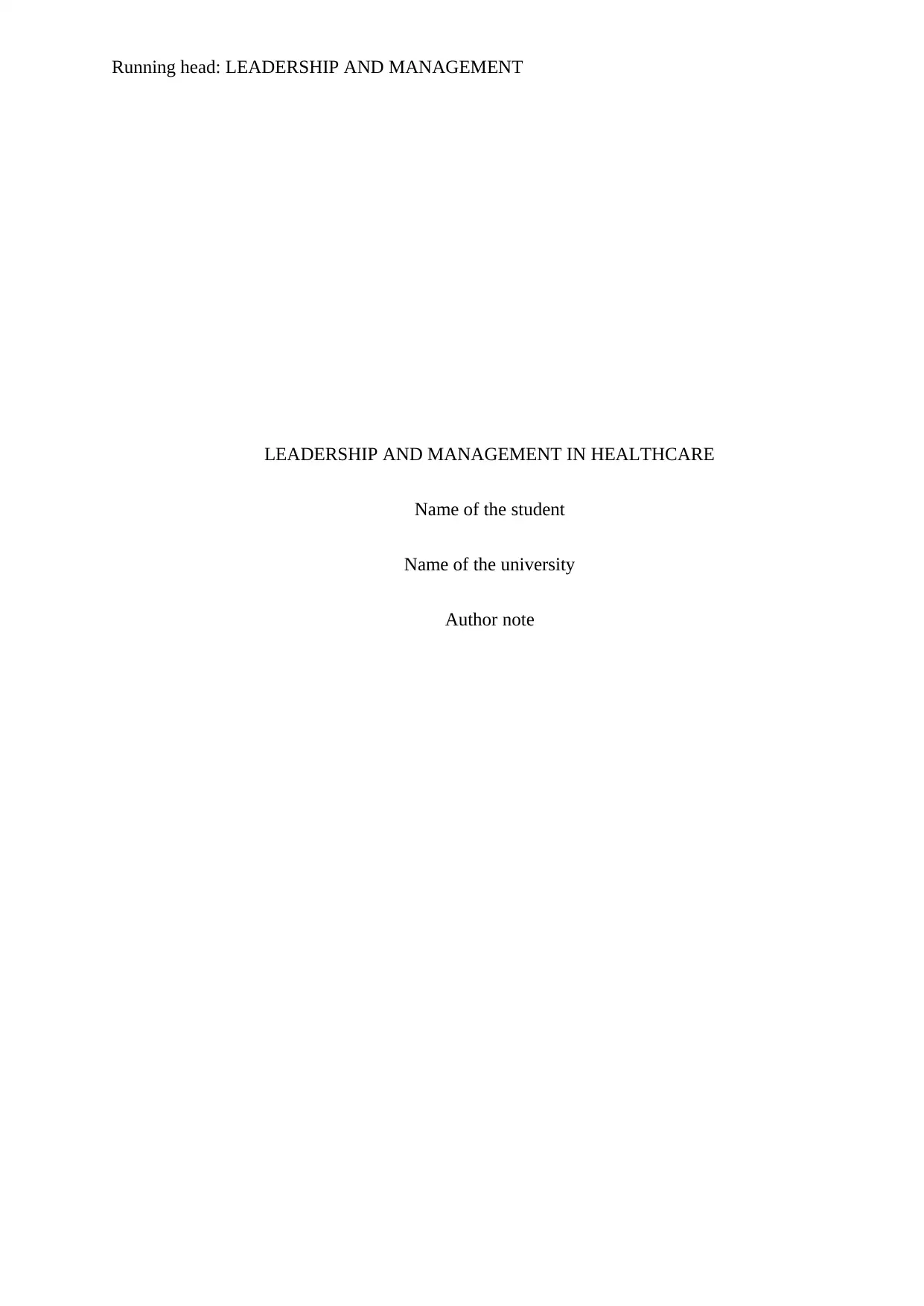
Running head: LEADERSHIP AND MANAGEMENT
LEADERSHIP AND MANAGEMENT IN HEALTHCARE
Name of the student
Name of the university
Author note
LEADERSHIP AND MANAGEMENT IN HEALTHCARE
Name of the student
Name of the university
Author note
Secure Best Marks with AI Grader
Need help grading? Try our AI Grader for instant feedback on your assignments.
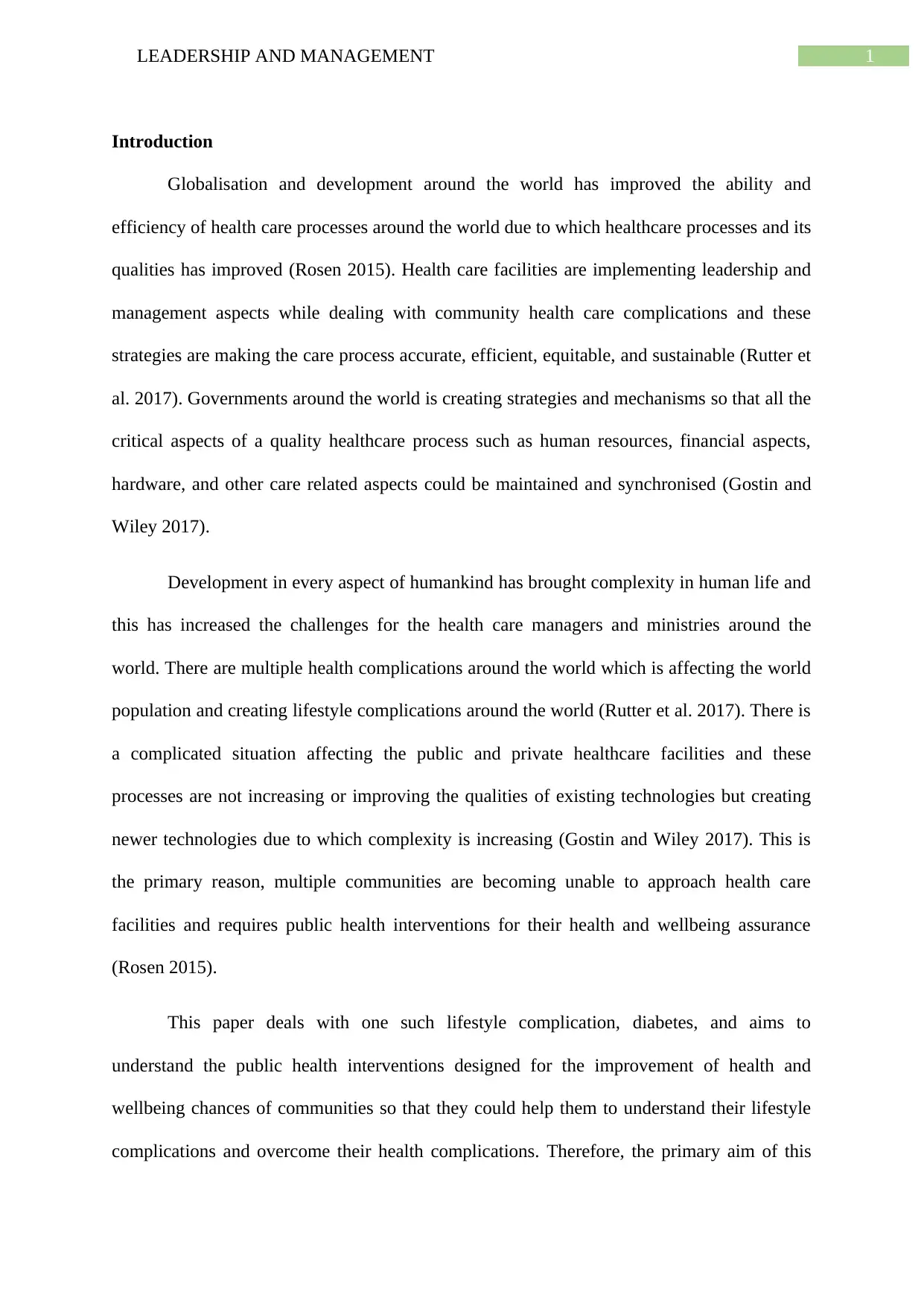
1LEADERSHIP AND MANAGEMENT
Introduction
Globalisation and development around the world has improved the ability and
efficiency of health care processes around the world due to which healthcare processes and its
qualities has improved (Rosen 2015). Health care facilities are implementing leadership and
management aspects while dealing with community health care complications and these
strategies are making the care process accurate, efficient, equitable, and sustainable (Rutter et
al. 2017). Governments around the world is creating strategies and mechanisms so that all the
critical aspects of a quality healthcare process such as human resources, financial aspects,
hardware, and other care related aspects could be maintained and synchronised (Gostin and
Wiley 2017).
Development in every aspect of humankind has brought complexity in human life and
this has increased the challenges for the health care managers and ministries around the
world. There are multiple health complications around the world which is affecting the world
population and creating lifestyle complications around the world (Rutter et al. 2017). There is
a complicated situation affecting the public and private healthcare facilities and these
processes are not increasing or improving the qualities of existing technologies but creating
newer technologies due to which complexity is increasing (Gostin and Wiley 2017). This is
the primary reason, multiple communities are becoming unable to approach health care
facilities and requires public health interventions for their health and wellbeing assurance
(Rosen 2015).
This paper deals with one such lifestyle complication, diabetes, and aims to
understand the public health interventions designed for the improvement of health and
wellbeing chances of communities so that they could help them to understand their lifestyle
complications and overcome their health complications. Therefore, the primary aim of this
Introduction
Globalisation and development around the world has improved the ability and
efficiency of health care processes around the world due to which healthcare processes and its
qualities has improved (Rosen 2015). Health care facilities are implementing leadership and
management aspects while dealing with community health care complications and these
strategies are making the care process accurate, efficient, equitable, and sustainable (Rutter et
al. 2017). Governments around the world is creating strategies and mechanisms so that all the
critical aspects of a quality healthcare process such as human resources, financial aspects,
hardware, and other care related aspects could be maintained and synchronised (Gostin and
Wiley 2017).
Development in every aspect of humankind has brought complexity in human life and
this has increased the challenges for the health care managers and ministries around the
world. There are multiple health complications around the world which is affecting the world
population and creating lifestyle complications around the world (Rutter et al. 2017). There is
a complicated situation affecting the public and private healthcare facilities and these
processes are not increasing or improving the qualities of existing technologies but creating
newer technologies due to which complexity is increasing (Gostin and Wiley 2017). This is
the primary reason, multiple communities are becoming unable to approach health care
facilities and requires public health interventions for their health and wellbeing assurance
(Rosen 2015).
This paper deals with one such lifestyle complication, diabetes, and aims to
understand the public health interventions designed for the improvement of health and
wellbeing chances of communities so that they could help them to understand their lifestyle
complications and overcome their health complications. Therefore, the primary aim of this
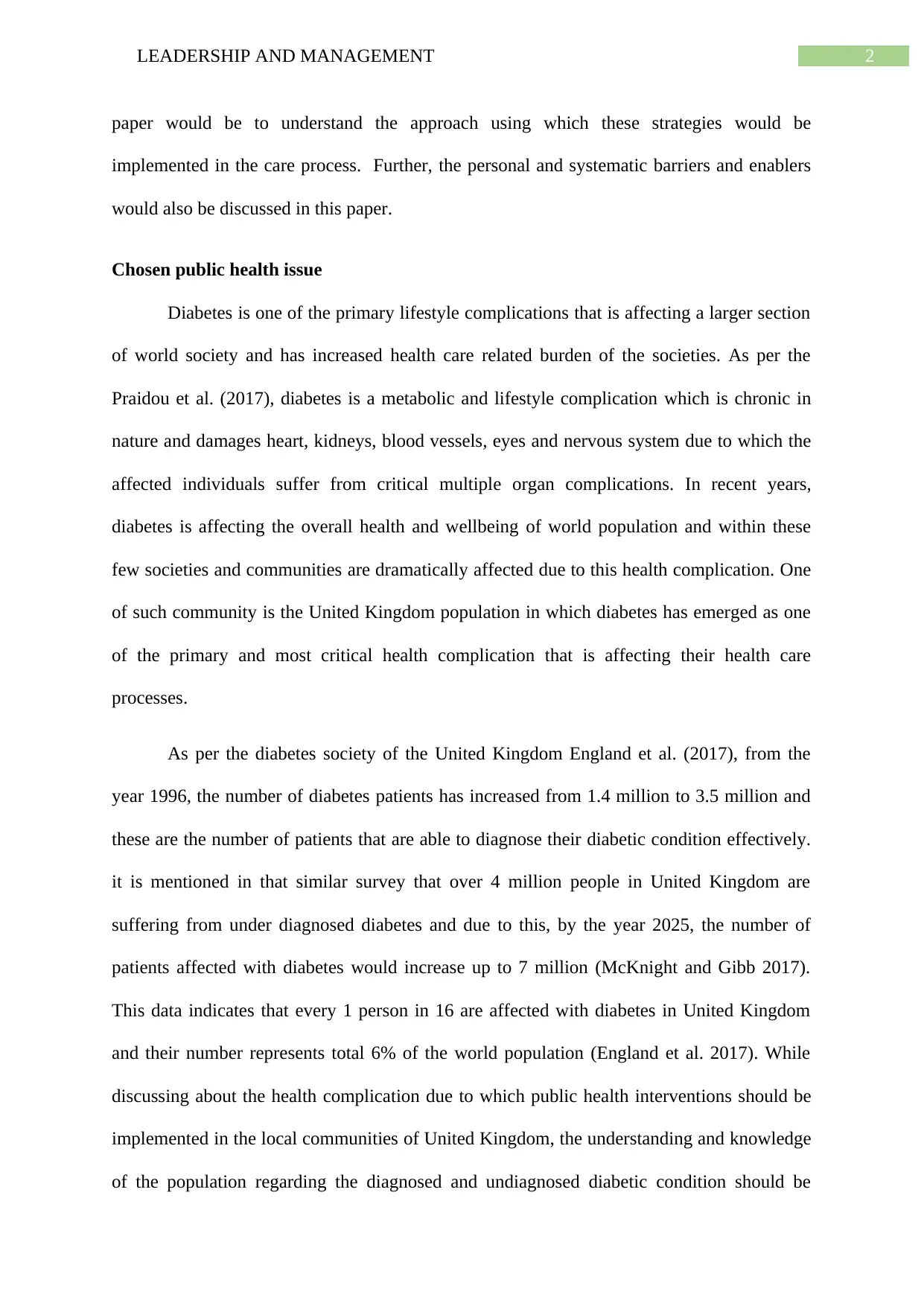
2LEADERSHIP AND MANAGEMENT
paper would be to understand the approach using which these strategies would be
implemented in the care process. Further, the personal and systematic barriers and enablers
would also be discussed in this paper.
Chosen public health issue
Diabetes is one of the primary lifestyle complications that is affecting a larger section
of world society and has increased health care related burden of the societies. As per the
Praidou et al. (2017), diabetes is a metabolic and lifestyle complication which is chronic in
nature and damages heart, kidneys, blood vessels, eyes and nervous system due to which the
affected individuals suffer from critical multiple organ complications. In recent years,
diabetes is affecting the overall health and wellbeing of world population and within these
few societies and communities are dramatically affected due to this health complication. One
of such community is the United Kingdom population in which diabetes has emerged as one
of the primary and most critical health complication that is affecting their health care
processes.
As per the diabetes society of the United Kingdom England et al. (2017), from the
year 1996, the number of diabetes patients has increased from 1.4 million to 3.5 million and
these are the number of patients that are able to diagnose their diabetic condition effectively.
it is mentioned in that similar survey that over 4 million people in United Kingdom are
suffering from under diagnosed diabetes and due to this, by the year 2025, the number of
patients affected with diabetes would increase up to 7 million (McKnight and Gibb 2017).
This data indicates that every 1 person in 16 are affected with diabetes in United Kingdom
and their number represents total 6% of the world population (England et al. 2017). While
discussing about the health complication due to which public health interventions should be
implemented in the local communities of United Kingdom, the understanding and knowledge
of the population regarding the diagnosed and undiagnosed diabetic condition should be
paper would be to understand the approach using which these strategies would be
implemented in the care process. Further, the personal and systematic barriers and enablers
would also be discussed in this paper.
Chosen public health issue
Diabetes is one of the primary lifestyle complications that is affecting a larger section
of world society and has increased health care related burden of the societies. As per the
Praidou et al. (2017), diabetes is a metabolic and lifestyle complication which is chronic in
nature and damages heart, kidneys, blood vessels, eyes and nervous system due to which the
affected individuals suffer from critical multiple organ complications. In recent years,
diabetes is affecting the overall health and wellbeing of world population and within these
few societies and communities are dramatically affected due to this health complication. One
of such community is the United Kingdom population in which diabetes has emerged as one
of the primary and most critical health complication that is affecting their health care
processes.
As per the diabetes society of the United Kingdom England et al. (2017), from the
year 1996, the number of diabetes patients has increased from 1.4 million to 3.5 million and
these are the number of patients that are able to diagnose their diabetic condition effectively.
it is mentioned in that similar survey that over 4 million people in United Kingdom are
suffering from under diagnosed diabetes and due to this, by the year 2025, the number of
patients affected with diabetes would increase up to 7 million (McKnight and Gibb 2017).
This data indicates that every 1 person in 16 are affected with diabetes in United Kingdom
and their number represents total 6% of the world population (England et al. 2017). While
discussing about the health complication due to which public health interventions should be
implemented in the local communities of United Kingdom, the understanding and knowledge
of the population regarding the diagnosed and undiagnosed diabetic condition should be
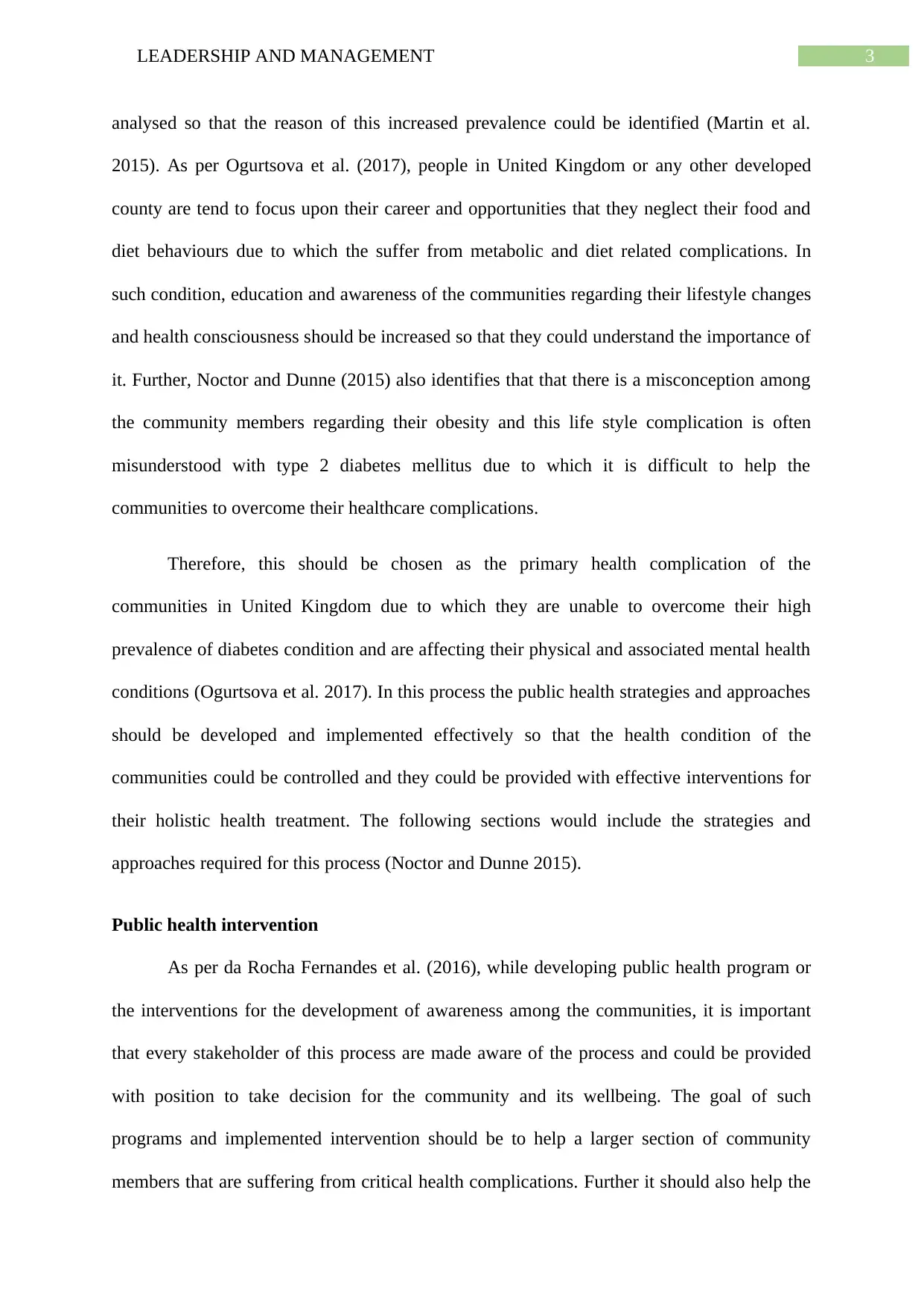
3LEADERSHIP AND MANAGEMENT
analysed so that the reason of this increased prevalence could be identified (Martin et al.
2015). As per Ogurtsova et al. (2017), people in United Kingdom or any other developed
county are tend to focus upon their career and opportunities that they neglect their food and
diet behaviours due to which the suffer from metabolic and diet related complications. In
such condition, education and awareness of the communities regarding their lifestyle changes
and health consciousness should be increased so that they could understand the importance of
it. Further, Noctor and Dunne (2015) also identifies that that there is a misconception among
the community members regarding their obesity and this life style complication is often
misunderstood with type 2 diabetes mellitus due to which it is difficult to help the
communities to overcome their healthcare complications.
Therefore, this should be chosen as the primary health complication of the
communities in United Kingdom due to which they are unable to overcome their high
prevalence of diabetes condition and are affecting their physical and associated mental health
conditions (Ogurtsova et al. 2017). In this process the public health strategies and approaches
should be developed and implemented effectively so that the health condition of the
communities could be controlled and they could be provided with effective interventions for
their holistic health treatment. The following sections would include the strategies and
approaches required for this process (Noctor and Dunne 2015).
Public health intervention
As per da Rocha Fernandes et al. (2016), while developing public health program or
the interventions for the development of awareness among the communities, it is important
that every stakeholder of this process are made aware of the process and could be provided
with position to take decision for the community and its wellbeing. The goal of such
programs and implemented intervention should be to help a larger section of community
members that are suffering from critical health complications. Further it should also help the
analysed so that the reason of this increased prevalence could be identified (Martin et al.
2015). As per Ogurtsova et al. (2017), people in United Kingdom or any other developed
county are tend to focus upon their career and opportunities that they neglect their food and
diet behaviours due to which the suffer from metabolic and diet related complications. In
such condition, education and awareness of the communities regarding their lifestyle changes
and health consciousness should be increased so that they could understand the importance of
it. Further, Noctor and Dunne (2015) also identifies that that there is a misconception among
the community members regarding their obesity and this life style complication is often
misunderstood with type 2 diabetes mellitus due to which it is difficult to help the
communities to overcome their healthcare complications.
Therefore, this should be chosen as the primary health complication of the
communities in United Kingdom due to which they are unable to overcome their high
prevalence of diabetes condition and are affecting their physical and associated mental health
conditions (Ogurtsova et al. 2017). In this process the public health strategies and approaches
should be developed and implemented effectively so that the health condition of the
communities could be controlled and they could be provided with effective interventions for
their holistic health treatment. The following sections would include the strategies and
approaches required for this process (Noctor and Dunne 2015).
Public health intervention
As per da Rocha Fernandes et al. (2016), while developing public health program or
the interventions for the development of awareness among the communities, it is important
that every stakeholder of this process are made aware of the process and could be provided
with position to take decision for the community and its wellbeing. The goal of such
programs and implemented intervention should be to help a larger section of community
members that are suffering from critical health complications. Further it should also help the
Secure Best Marks with AI Grader
Need help grading? Try our AI Grader for instant feedback on your assignments.
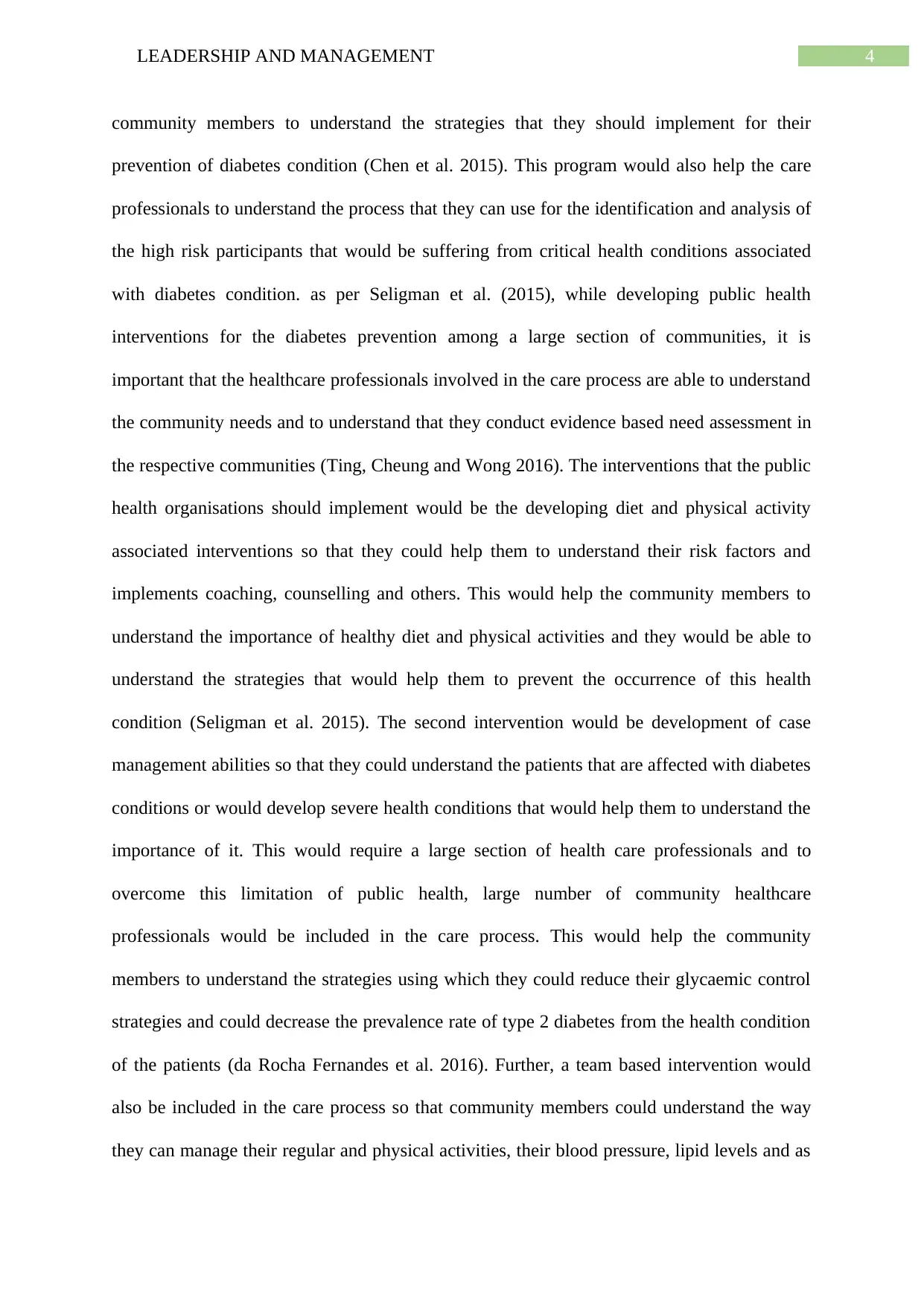
4LEADERSHIP AND MANAGEMENT
community members to understand the strategies that they should implement for their
prevention of diabetes condition (Chen et al. 2015). This program would also help the care
professionals to understand the process that they can use for the identification and analysis of
the high risk participants that would be suffering from critical health conditions associated
with diabetes condition. as per Seligman et al. (2015), while developing public health
interventions for the diabetes prevention among a large section of communities, it is
important that the healthcare professionals involved in the care process are able to understand
the community needs and to understand that they conduct evidence based need assessment in
the respective communities (Ting, Cheung and Wong 2016). The interventions that the public
health organisations should implement would be the developing diet and physical activity
associated interventions so that they could help them to understand their risk factors and
implements coaching, counselling and others. This would help the community members to
understand the importance of healthy diet and physical activities and they would be able to
understand the strategies that would help them to prevent the occurrence of this health
condition (Seligman et al. 2015). The second intervention would be development of case
management abilities so that they could understand the patients that are affected with diabetes
conditions or would develop severe health conditions that would help them to understand the
importance of it. This would require a large section of health care professionals and to
overcome this limitation of public health, large number of community healthcare
professionals would be included in the care process. This would help the community
members to understand the strategies using which they could reduce their glycaemic control
strategies and could decrease the prevalence rate of type 2 diabetes from the health condition
of the patients (da Rocha Fernandes et al. 2016). Further, a team based intervention would
also be included in the care process so that community members could understand the way
they can manage their regular and physical activities, their blood pressure, lipid levels and as
community members to understand the strategies that they should implement for their
prevention of diabetes condition (Chen et al. 2015). This program would also help the care
professionals to understand the process that they can use for the identification and analysis of
the high risk participants that would be suffering from critical health conditions associated
with diabetes condition. as per Seligman et al. (2015), while developing public health
interventions for the diabetes prevention among a large section of communities, it is
important that the healthcare professionals involved in the care process are able to understand
the community needs and to understand that they conduct evidence based need assessment in
the respective communities (Ting, Cheung and Wong 2016). The interventions that the public
health organisations should implement would be the developing diet and physical activity
associated interventions so that they could help them to understand their risk factors and
implements coaching, counselling and others. This would help the community members to
understand the importance of healthy diet and physical activities and they would be able to
understand the strategies that would help them to prevent the occurrence of this health
condition (Seligman et al. 2015). The second intervention would be development of case
management abilities so that they could understand the patients that are affected with diabetes
conditions or would develop severe health conditions that would help them to understand the
importance of it. This would require a large section of health care professionals and to
overcome this limitation of public health, large number of community healthcare
professionals would be included in the care process. This would help the community
members to understand the strategies using which they could reduce their glycaemic control
strategies and could decrease the prevalence rate of type 2 diabetes from the health condition
of the patients (da Rocha Fernandes et al. 2016). Further, a team based intervention would
also be included in the care process so that community members could understand the way
they can manage their regular and physical activities, their blood pressure, lipid levels and as
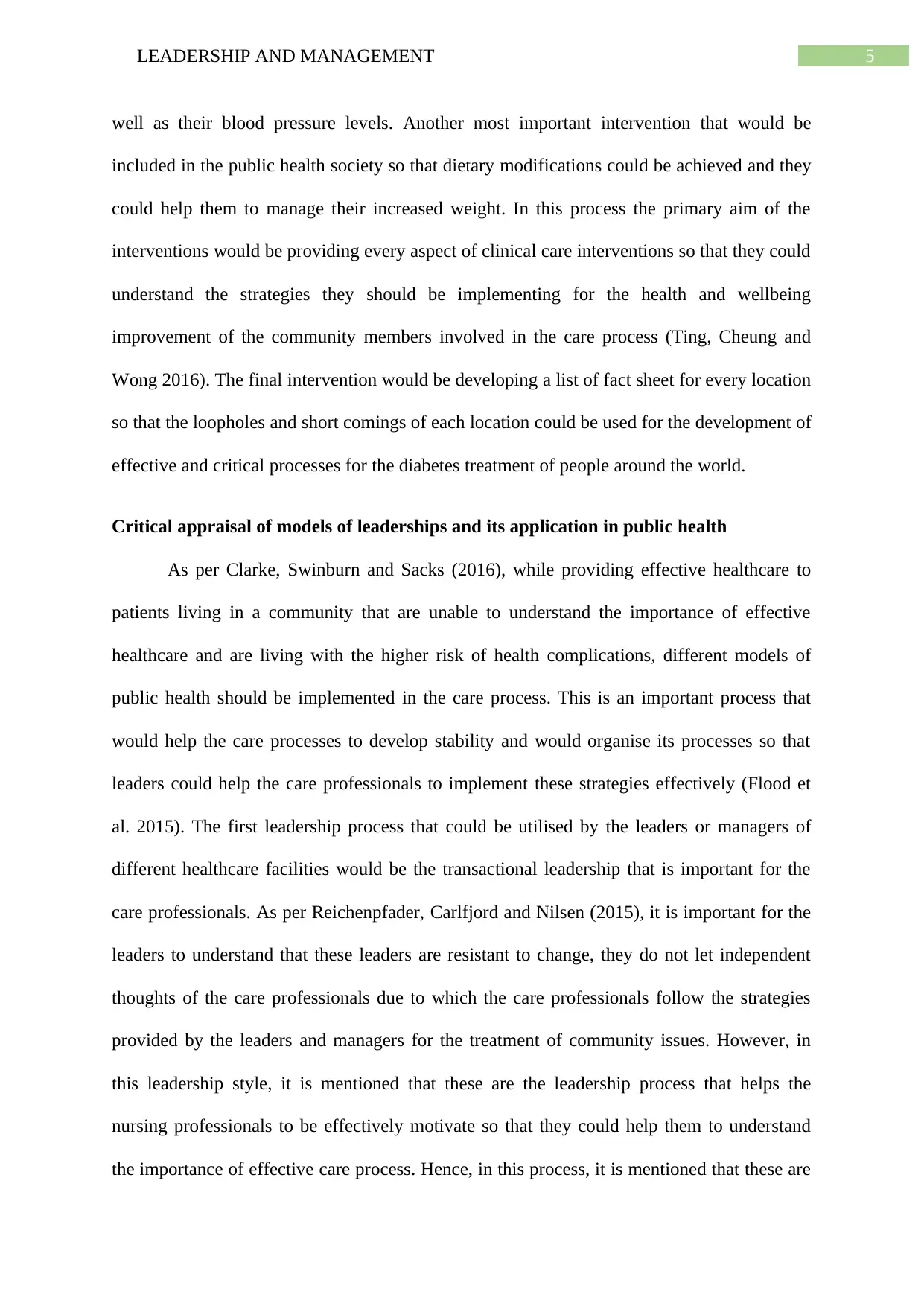
5LEADERSHIP AND MANAGEMENT
well as their blood pressure levels. Another most important intervention that would be
included in the public health society so that dietary modifications could be achieved and they
could help them to manage their increased weight. In this process the primary aim of the
interventions would be providing every aspect of clinical care interventions so that they could
understand the strategies they should be implementing for the health and wellbeing
improvement of the community members involved in the care process (Ting, Cheung and
Wong 2016). The final intervention would be developing a list of fact sheet for every location
so that the loopholes and short comings of each location could be used for the development of
effective and critical processes for the diabetes treatment of people around the world.
Critical appraisal of models of leaderships and its application in public health
As per Clarke, Swinburn and Sacks (2016), while providing effective healthcare to
patients living in a community that are unable to understand the importance of effective
healthcare and are living with the higher risk of health complications, different models of
public health should be implemented in the care process. This is an important process that
would help the care processes to develop stability and would organise its processes so that
leaders could help the care professionals to implement these strategies effectively (Flood et
al. 2015). The first leadership process that could be utilised by the leaders or managers of
different healthcare facilities would be the transactional leadership that is important for the
care professionals. As per Reichenpfader, Carlfjord and Nilsen (2015), it is important for the
leaders to understand that these leaders are resistant to change, they do not let independent
thoughts of the care professionals due to which the care professionals follow the strategies
provided by the leaders and managers for the treatment of community issues. However, in
this leadership style, it is mentioned that these are the leadership process that helps the
nursing professionals to be effectively motivate so that they could help them to understand
the importance of effective care process. Hence, in this process, it is mentioned that these are
well as their blood pressure levels. Another most important intervention that would be
included in the public health society so that dietary modifications could be achieved and they
could help them to manage their increased weight. In this process the primary aim of the
interventions would be providing every aspect of clinical care interventions so that they could
understand the strategies they should be implementing for the health and wellbeing
improvement of the community members involved in the care process (Ting, Cheung and
Wong 2016). The final intervention would be developing a list of fact sheet for every location
so that the loopholes and short comings of each location could be used for the development of
effective and critical processes for the diabetes treatment of people around the world.
Critical appraisal of models of leaderships and its application in public health
As per Clarke, Swinburn and Sacks (2016), while providing effective healthcare to
patients living in a community that are unable to understand the importance of effective
healthcare and are living with the higher risk of health complications, different models of
public health should be implemented in the care process. This is an important process that
would help the care processes to develop stability and would organise its processes so that
leaders could help the care professionals to implement these strategies effectively (Flood et
al. 2015). The first leadership process that could be utilised by the leaders or managers of
different healthcare facilities would be the transactional leadership that is important for the
care professionals. As per Reichenpfader, Carlfjord and Nilsen (2015), it is important for the
leaders to understand that these leaders are resistant to change, they do not let independent
thoughts of the care professionals due to which the care professionals follow the strategies
provided by the leaders and managers for the treatment of community issues. However, in
this leadership style, it is mentioned that these are the leadership process that helps the
nursing professionals to be effectively motivate so that they could help them to understand
the importance of effective care process. Hence, in this process, it is mentioned that these are
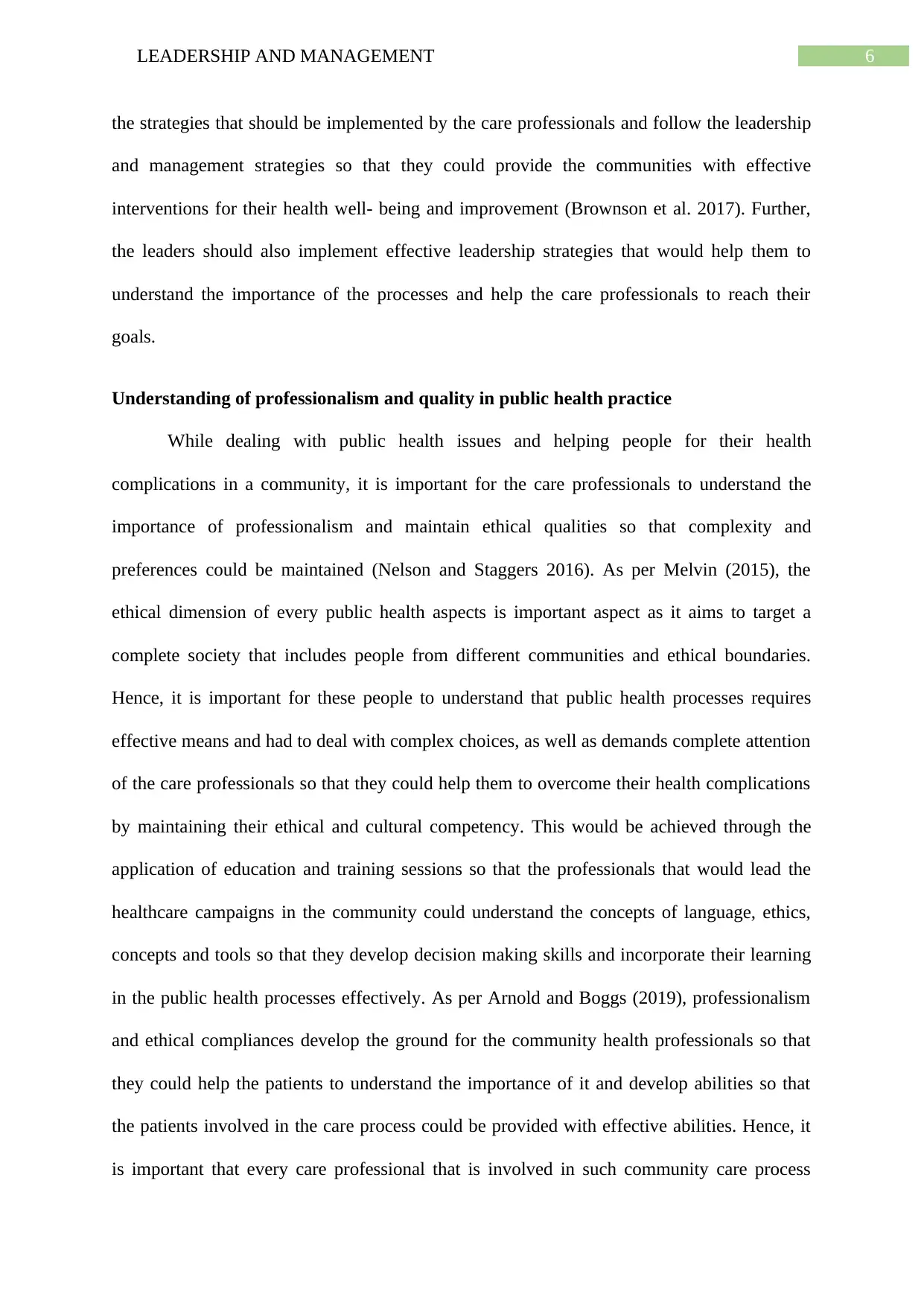
6LEADERSHIP AND MANAGEMENT
the strategies that should be implemented by the care professionals and follow the leadership
and management strategies so that they could provide the communities with effective
interventions for their health well- being and improvement (Brownson et al. 2017). Further,
the leaders should also implement effective leadership strategies that would help them to
understand the importance of the processes and help the care professionals to reach their
goals.
Understanding of professionalism and quality in public health practice
While dealing with public health issues and helping people for their health
complications in a community, it is important for the care professionals to understand the
importance of professionalism and maintain ethical qualities so that complexity and
preferences could be maintained (Nelson and Staggers 2016). As per Melvin (2015), the
ethical dimension of every public health aspects is important aspect as it aims to target a
complete society that includes people from different communities and ethical boundaries.
Hence, it is important for these people to understand that public health processes requires
effective means and had to deal with complex choices, as well as demands complete attention
of the care professionals so that they could help them to overcome their health complications
by maintaining their ethical and cultural competency. This would be achieved through the
application of education and training sessions so that the professionals that would lead the
healthcare campaigns in the community could understand the concepts of language, ethics,
concepts and tools so that they develop decision making skills and incorporate their learning
in the public health processes effectively. As per Arnold and Boggs (2019), professionalism
and ethical compliances develop the ground for the community health professionals so that
they could help the patients to understand the importance of it and develop abilities so that
the patients involved in the care process could be provided with effective abilities. Hence, it
is important that every care professional that is involved in such community care process
the strategies that should be implemented by the care professionals and follow the leadership
and management strategies so that they could provide the communities with effective
interventions for their health well- being and improvement (Brownson et al. 2017). Further,
the leaders should also implement effective leadership strategies that would help them to
understand the importance of the processes and help the care professionals to reach their
goals.
Understanding of professionalism and quality in public health practice
While dealing with public health issues and helping people for their health
complications in a community, it is important for the care professionals to understand the
importance of professionalism and maintain ethical qualities so that complexity and
preferences could be maintained (Nelson and Staggers 2016). As per Melvin (2015), the
ethical dimension of every public health aspects is important aspect as it aims to target a
complete society that includes people from different communities and ethical boundaries.
Hence, it is important for these people to understand that public health processes requires
effective means and had to deal with complex choices, as well as demands complete attention
of the care professionals so that they could help them to overcome their health complications
by maintaining their ethical and cultural competency. This would be achieved through the
application of education and training sessions so that the professionals that would lead the
healthcare campaigns in the community could understand the concepts of language, ethics,
concepts and tools so that they develop decision making skills and incorporate their learning
in the public health processes effectively. As per Arnold and Boggs (2019), professionalism
and ethical compliances develop the ground for the community health professionals so that
they could help the patients to understand the importance of it and develop abilities so that
the patients involved in the care process could be provided with effective abilities. Hence, it
is important that every care professional that is involved in such community care process
Paraphrase This Document
Need a fresh take? Get an instant paraphrase of this document with our AI Paraphraser
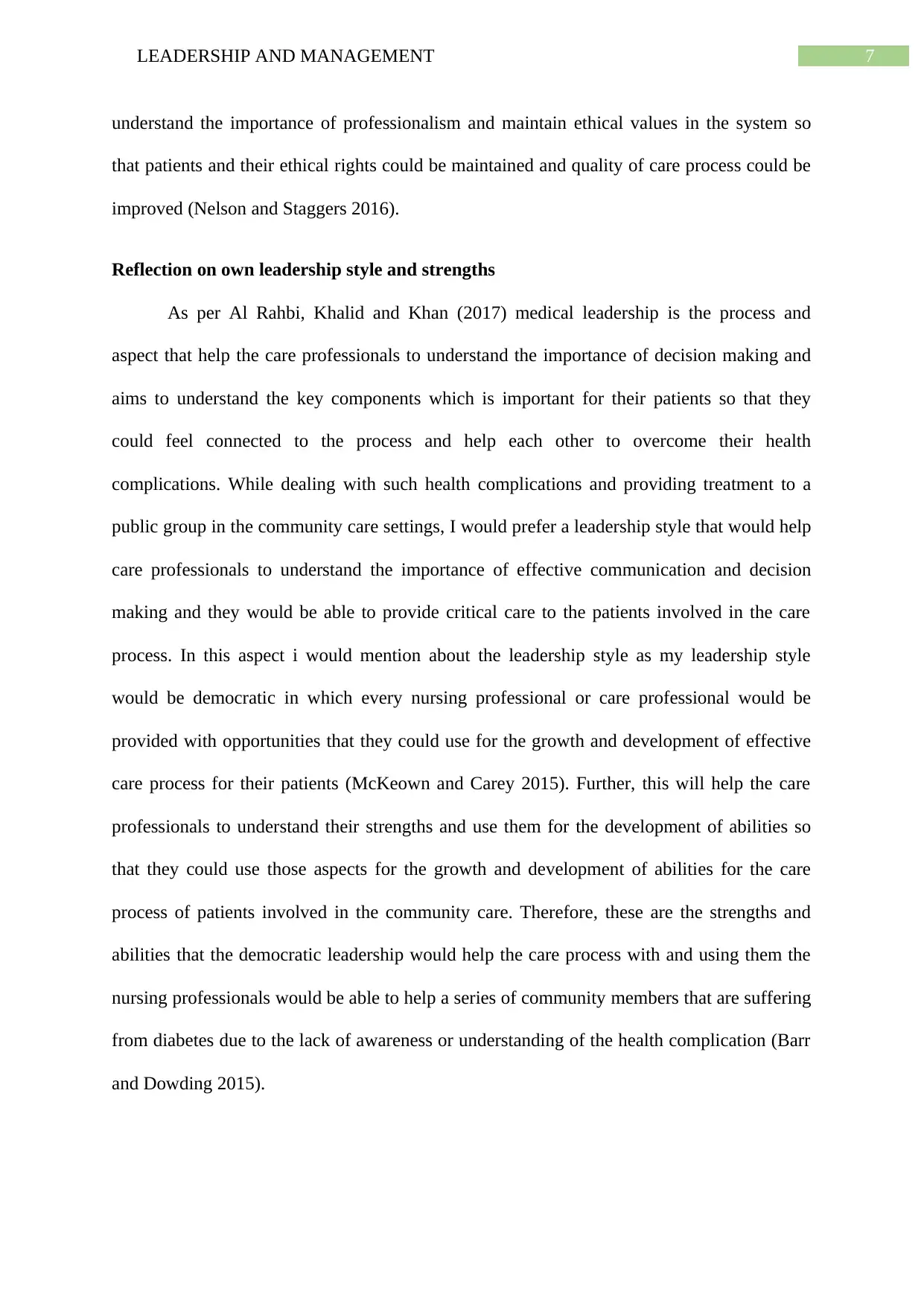
7LEADERSHIP AND MANAGEMENT
understand the importance of professionalism and maintain ethical values in the system so
that patients and their ethical rights could be maintained and quality of care process could be
improved (Nelson and Staggers 2016).
Reflection on own leadership style and strengths
As per Al Rahbi, Khalid and Khan (2017) medical leadership is the process and
aspect that help the care professionals to understand the importance of decision making and
aims to understand the key components which is important for their patients so that they
could feel connected to the process and help each other to overcome their health
complications. While dealing with such health complications and providing treatment to a
public group in the community care settings, I would prefer a leadership style that would help
care professionals to understand the importance of effective communication and decision
making and they would be able to provide critical care to the patients involved in the care
process. In this aspect i would mention about the leadership style as my leadership style
would be democratic in which every nursing professional or care professional would be
provided with opportunities that they could use for the growth and development of effective
care process for their patients (McKeown and Carey 2015). Further, this will help the care
professionals to understand their strengths and use them for the development of abilities so
that they could use those aspects for the growth and development of abilities for the care
process of patients involved in the community care. Therefore, these are the strengths and
abilities that the democratic leadership would help the care process with and using them the
nursing professionals would be able to help a series of community members that are suffering
from diabetes due to the lack of awareness or understanding of the health complication (Barr
and Dowding 2015).
understand the importance of professionalism and maintain ethical values in the system so
that patients and their ethical rights could be maintained and quality of care process could be
improved (Nelson and Staggers 2016).
Reflection on own leadership style and strengths
As per Al Rahbi, Khalid and Khan (2017) medical leadership is the process and
aspect that help the care professionals to understand the importance of decision making and
aims to understand the key components which is important for their patients so that they
could feel connected to the process and help each other to overcome their health
complications. While dealing with such health complications and providing treatment to a
public group in the community care settings, I would prefer a leadership style that would help
care professionals to understand the importance of effective communication and decision
making and they would be able to provide critical care to the patients involved in the care
process. In this aspect i would mention about the leadership style as my leadership style
would be democratic in which every nursing professional or care professional would be
provided with opportunities that they could use for the growth and development of effective
care process for their patients (McKeown and Carey 2015). Further, this will help the care
professionals to understand their strengths and use them for the development of abilities so
that they could use those aspects for the growth and development of abilities for the care
process of patients involved in the community care. Therefore, these are the strengths and
abilities that the democratic leadership would help the care process with and using them the
nursing professionals would be able to help a series of community members that are suffering
from diabetes due to the lack of awareness or understanding of the health complication (Barr
and Dowding 2015).
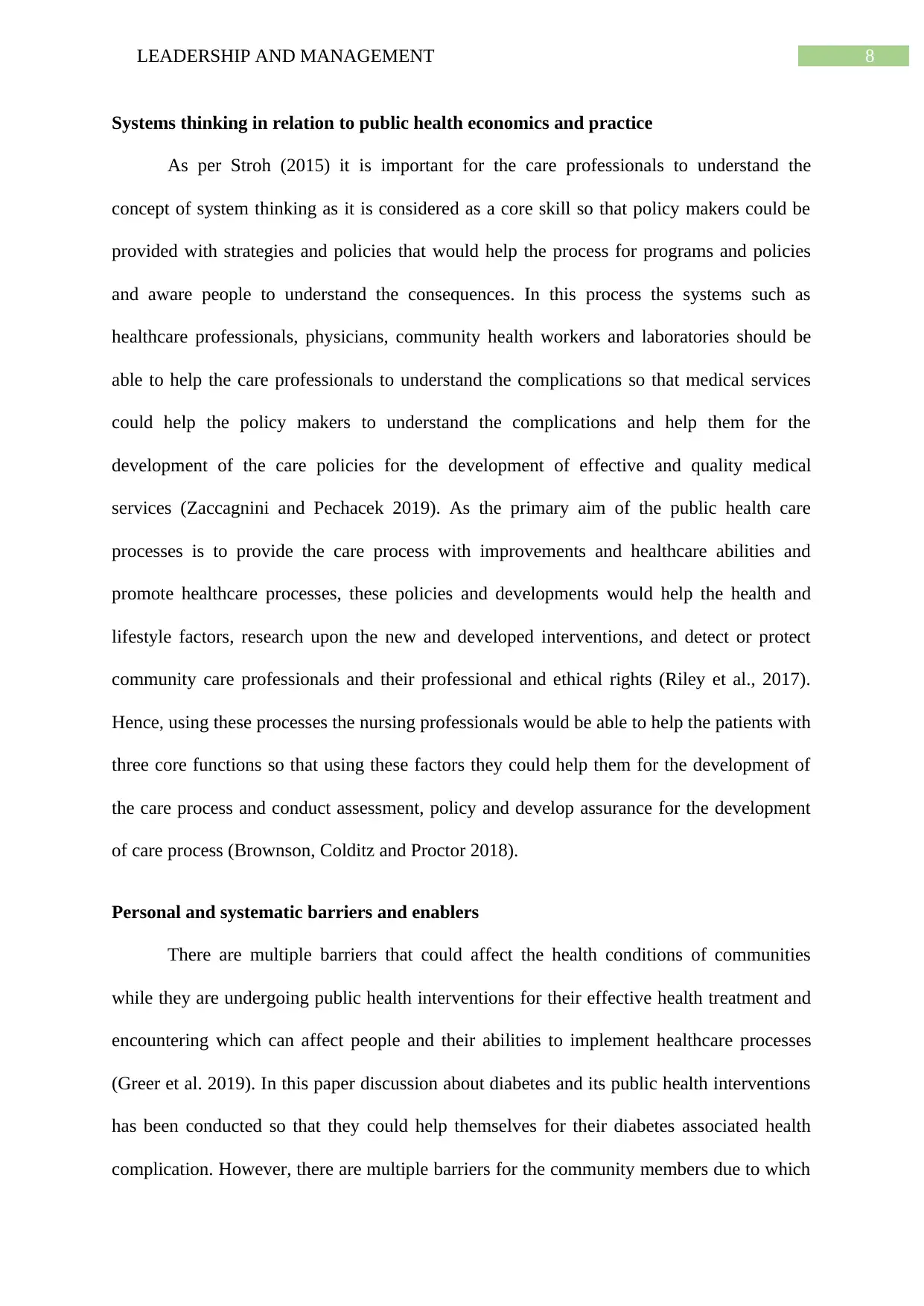
8LEADERSHIP AND MANAGEMENT
Systems thinking in relation to public health economics and practice
As per Stroh (2015) it is important for the care professionals to understand the
concept of system thinking as it is considered as a core skill so that policy makers could be
provided with strategies and policies that would help the process for programs and policies
and aware people to understand the consequences. In this process the systems such as
healthcare professionals, physicians, community health workers and laboratories should be
able to help the care professionals to understand the complications so that medical services
could help the policy makers to understand the complications and help them for the
development of the care policies for the development of effective and quality medical
services (Zaccagnini and Pechacek 2019). As the primary aim of the public health care
processes is to provide the care process with improvements and healthcare abilities and
promote healthcare processes, these policies and developments would help the health and
lifestyle factors, research upon the new and developed interventions, and detect or protect
community care professionals and their professional and ethical rights (Riley et al., 2017).
Hence, using these processes the nursing professionals would be able to help the patients with
three core functions so that using these factors they could help them for the development of
the care process and conduct assessment, policy and develop assurance for the development
of care process (Brownson, Colditz and Proctor 2018).
Personal and systematic barriers and enablers
There are multiple barriers that could affect the health conditions of communities
while they are undergoing public health interventions for their effective health treatment and
encountering which can affect people and their abilities to implement healthcare processes
(Greer et al. 2019). In this paper discussion about diabetes and its public health interventions
has been conducted so that they could help themselves for their diabetes associated health
complication. However, there are multiple barriers for the community members due to which
Systems thinking in relation to public health economics and practice
As per Stroh (2015) it is important for the care professionals to understand the
concept of system thinking as it is considered as a core skill so that policy makers could be
provided with strategies and policies that would help the process for programs and policies
and aware people to understand the consequences. In this process the systems such as
healthcare professionals, physicians, community health workers and laboratories should be
able to help the care professionals to understand the complications so that medical services
could help the policy makers to understand the complications and help them for the
development of the care policies for the development of effective and quality medical
services (Zaccagnini and Pechacek 2019). As the primary aim of the public health care
processes is to provide the care process with improvements and healthcare abilities and
promote healthcare processes, these policies and developments would help the health and
lifestyle factors, research upon the new and developed interventions, and detect or protect
community care professionals and their professional and ethical rights (Riley et al., 2017).
Hence, using these processes the nursing professionals would be able to help the patients with
three core functions so that using these factors they could help them for the development of
the care process and conduct assessment, policy and develop assurance for the development
of care process (Brownson, Colditz and Proctor 2018).
Personal and systematic barriers and enablers
There are multiple barriers that could affect the health conditions of communities
while they are undergoing public health interventions for their effective health treatment and
encountering which can affect people and their abilities to implement healthcare processes
(Greer et al. 2019). In this paper discussion about diabetes and its public health interventions
has been conducted so that they could help themselves for their diabetes associated health
complication. However, there are multiple barriers for the community members due to which
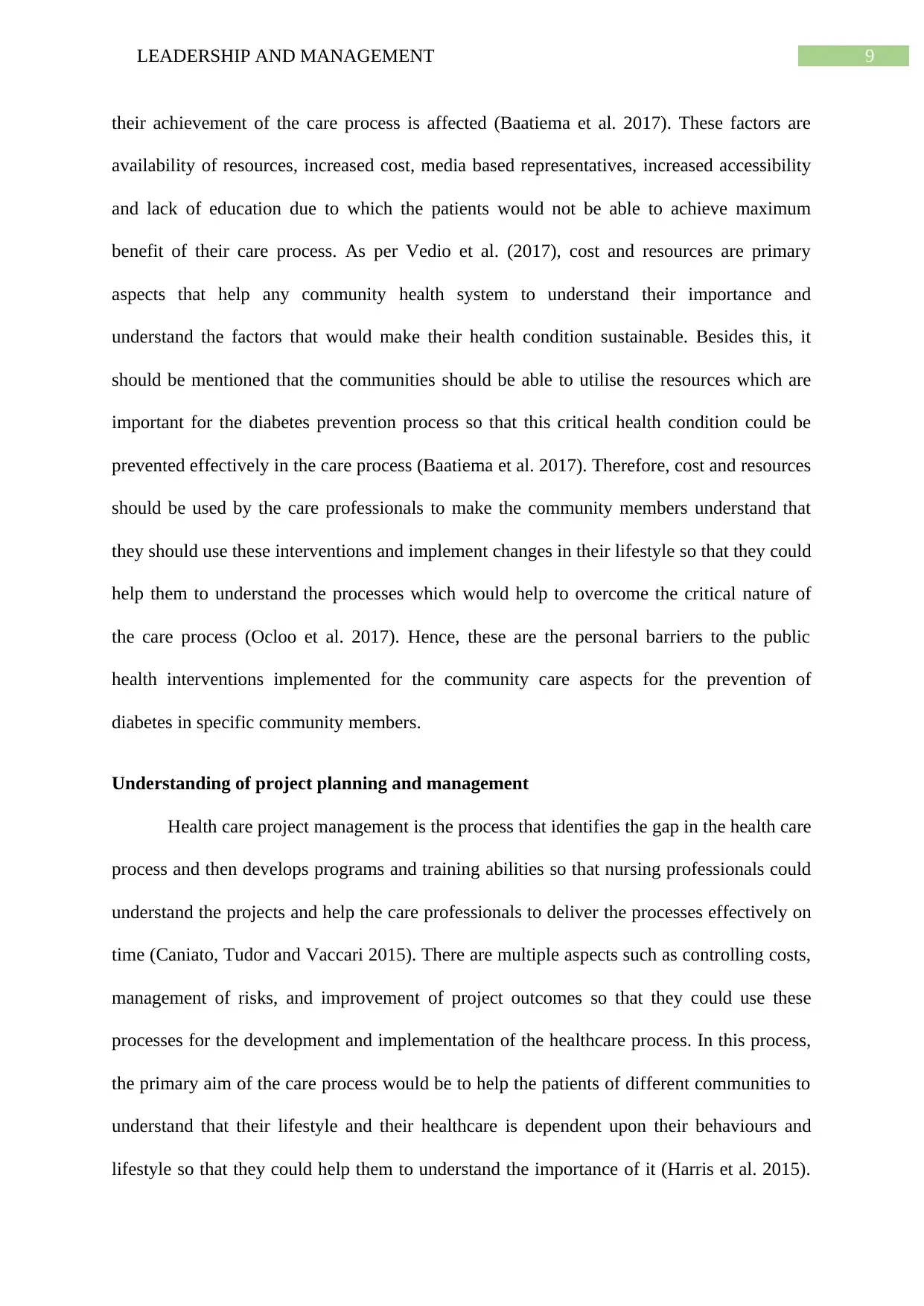
9LEADERSHIP AND MANAGEMENT
their achievement of the care process is affected (Baatiema et al. 2017). These factors are
availability of resources, increased cost, media based representatives, increased accessibility
and lack of education due to which the patients would not be able to achieve maximum
benefit of their care process. As per Vedio et al. (2017), cost and resources are primary
aspects that help any community health system to understand their importance and
understand the factors that would make their health condition sustainable. Besides this, it
should be mentioned that the communities should be able to utilise the resources which are
important for the diabetes prevention process so that this critical health condition could be
prevented effectively in the care process (Baatiema et al. 2017). Therefore, cost and resources
should be used by the care professionals to make the community members understand that
they should use these interventions and implement changes in their lifestyle so that they could
help them to understand the processes which would help to overcome the critical nature of
the care process (Ocloo et al. 2017). Hence, these are the personal barriers to the public
health interventions implemented for the community care aspects for the prevention of
diabetes in specific community members.
Understanding of project planning and management
Health care project management is the process that identifies the gap in the health care
process and then develops programs and training abilities so that nursing professionals could
understand the projects and help the care professionals to deliver the processes effectively on
time (Caniato, Tudor and Vaccari 2015). There are multiple aspects such as controlling costs,
management of risks, and improvement of project outcomes so that they could use these
processes for the development and implementation of the healthcare process. In this process,
the primary aim of the care process would be to help the patients of different communities to
understand that their lifestyle and their healthcare is dependent upon their behaviours and
lifestyle so that they could help them to understand the importance of it (Harris et al. 2015).
their achievement of the care process is affected (Baatiema et al. 2017). These factors are
availability of resources, increased cost, media based representatives, increased accessibility
and lack of education due to which the patients would not be able to achieve maximum
benefit of their care process. As per Vedio et al. (2017), cost and resources are primary
aspects that help any community health system to understand their importance and
understand the factors that would make their health condition sustainable. Besides this, it
should be mentioned that the communities should be able to utilise the resources which are
important for the diabetes prevention process so that this critical health condition could be
prevented effectively in the care process (Baatiema et al. 2017). Therefore, cost and resources
should be used by the care professionals to make the community members understand that
they should use these interventions and implement changes in their lifestyle so that they could
help them to understand the processes which would help to overcome the critical nature of
the care process (Ocloo et al. 2017). Hence, these are the personal barriers to the public
health interventions implemented for the community care aspects for the prevention of
diabetes in specific community members.
Understanding of project planning and management
Health care project management is the process that identifies the gap in the health care
process and then develops programs and training abilities so that nursing professionals could
understand the projects and help the care professionals to deliver the processes effectively on
time (Caniato, Tudor and Vaccari 2015). There are multiple aspects such as controlling costs,
management of risks, and improvement of project outcomes so that they could use these
processes for the development and implementation of the healthcare process. In this process,
the primary aim of the care process would be to help the patients of different communities to
understand that their lifestyle and their healthcare is dependent upon their behaviours and
lifestyle so that they could help them to understand the importance of it (Harris et al. 2015).
Secure Best Marks with AI Grader
Need help grading? Try our AI Grader for instant feedback on your assignments.
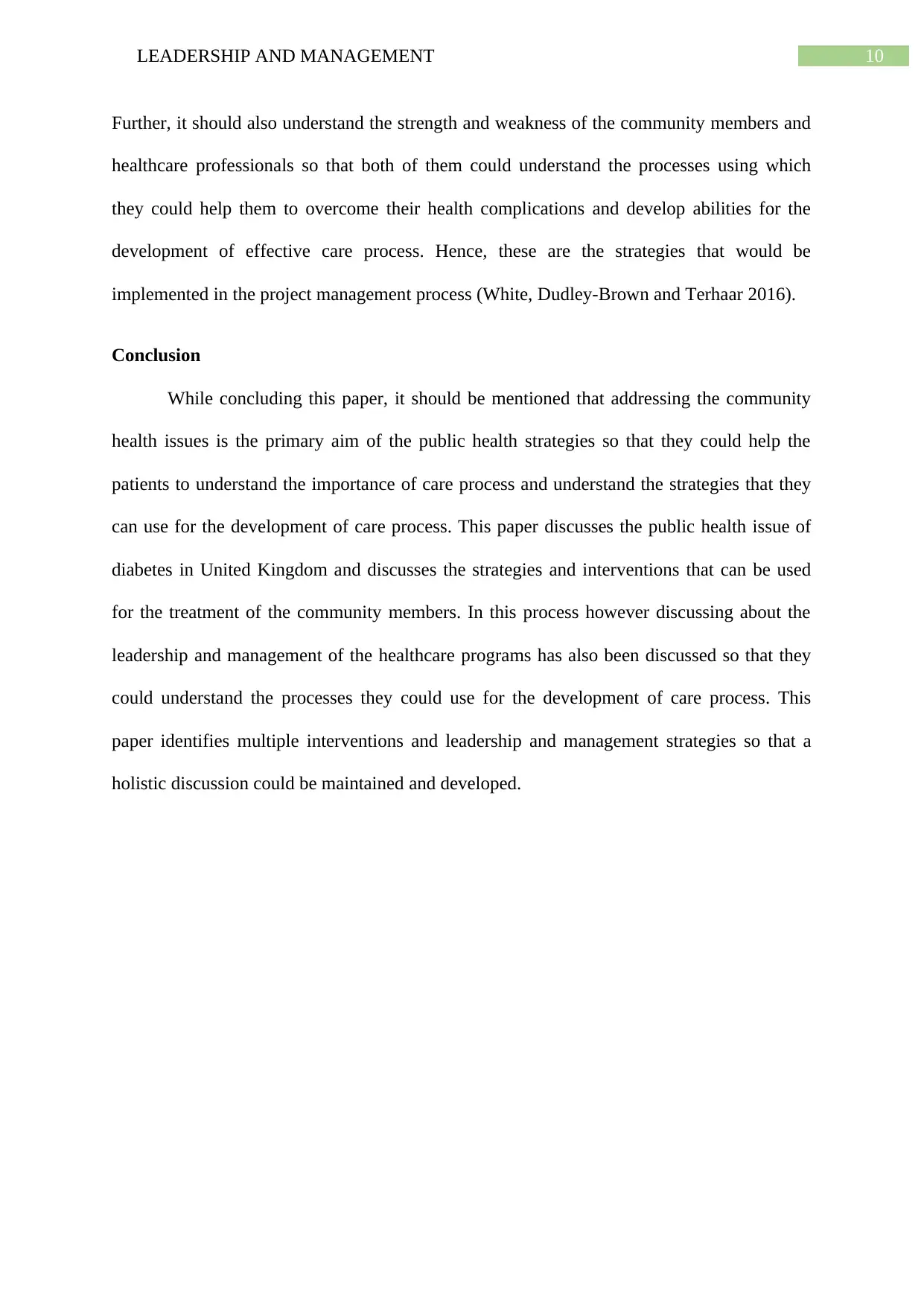
10LEADERSHIP AND MANAGEMENT
Further, it should also understand the strength and weakness of the community members and
healthcare professionals so that both of them could understand the processes using which
they could help them to overcome their health complications and develop abilities for the
development of effective care process. Hence, these are the strategies that would be
implemented in the project management process (White, Dudley-Brown and Terhaar 2016).
Conclusion
While concluding this paper, it should be mentioned that addressing the community
health issues is the primary aim of the public health strategies so that they could help the
patients to understand the importance of care process and understand the strategies that they
can use for the development of care process. This paper discusses the public health issue of
diabetes in United Kingdom and discusses the strategies and interventions that can be used
for the treatment of the community members. In this process however discussing about the
leadership and management of the healthcare programs has also been discussed so that they
could understand the processes they could use for the development of care process. This
paper identifies multiple interventions and leadership and management strategies so that a
holistic discussion could be maintained and developed.
Further, it should also understand the strength and weakness of the community members and
healthcare professionals so that both of them could understand the processes using which
they could help them to overcome their health complications and develop abilities for the
development of effective care process. Hence, these are the strategies that would be
implemented in the project management process (White, Dudley-Brown and Terhaar 2016).
Conclusion
While concluding this paper, it should be mentioned that addressing the community
health issues is the primary aim of the public health strategies so that they could help the
patients to understand the importance of care process and understand the strategies that they
can use for the development of care process. This paper discusses the public health issue of
diabetes in United Kingdom and discusses the strategies and interventions that can be used
for the treatment of the community members. In this process however discussing about the
leadership and management of the healthcare programs has also been discussed so that they
could understand the processes they could use for the development of care process. This
paper identifies multiple interventions and leadership and management strategies so that a
holistic discussion could be maintained and developed.
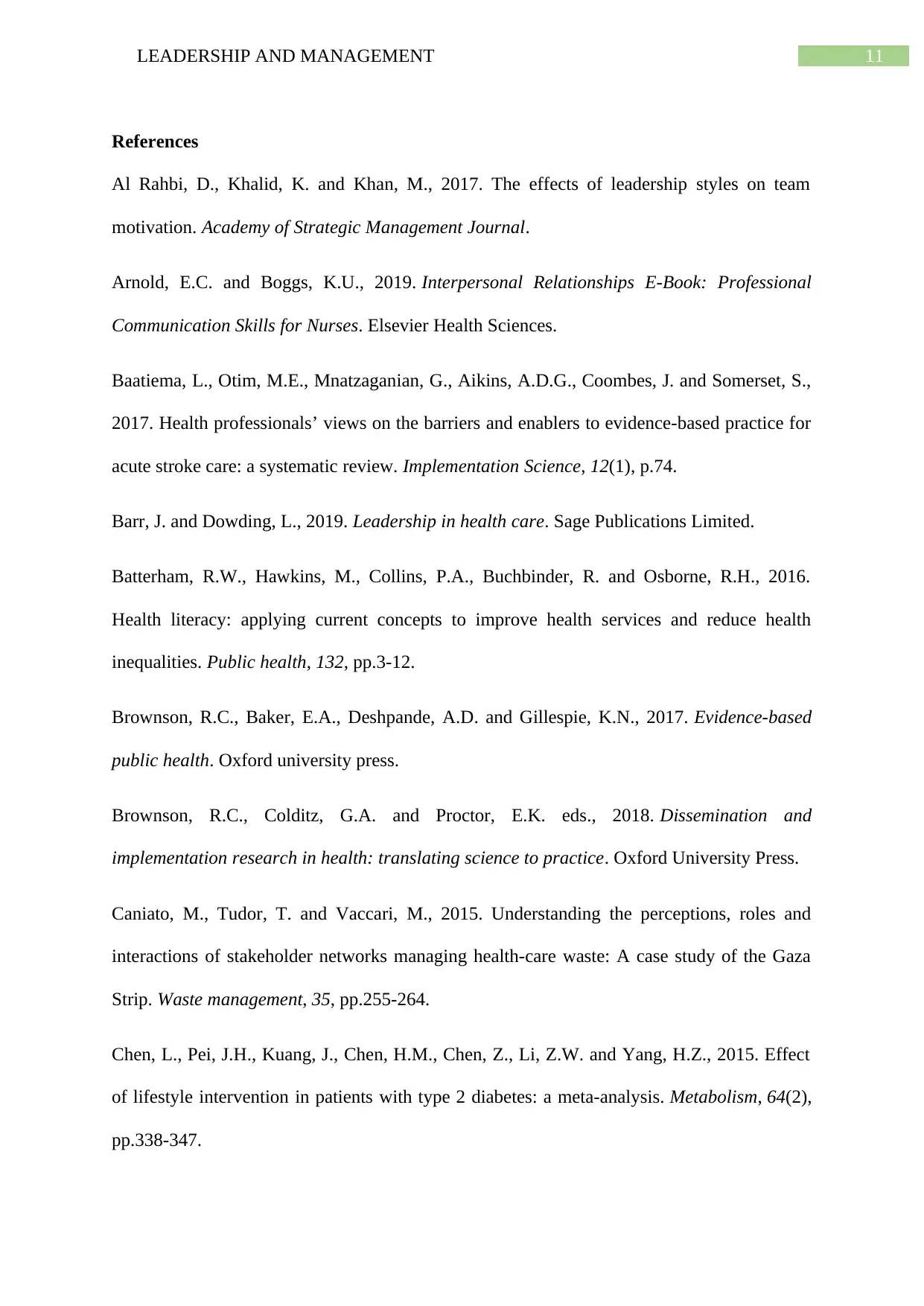
11LEADERSHIP AND MANAGEMENT
References
Al Rahbi, D., Khalid, K. and Khan, M., 2017. The effects of leadership styles on team
motivation. Academy of Strategic Management Journal.
Arnold, E.C. and Boggs, K.U., 2019. Interpersonal Relationships E-Book: Professional
Communication Skills for Nurses. Elsevier Health Sciences.
Baatiema, L., Otim, M.E., Mnatzaganian, G., Aikins, A.D.G., Coombes, J. and Somerset, S.,
2017. Health professionals’ views on the barriers and enablers to evidence-based practice for
acute stroke care: a systematic review. Implementation Science, 12(1), p.74.
Barr, J. and Dowding, L., 2019. Leadership in health care. Sage Publications Limited.
Batterham, R.W., Hawkins, M., Collins, P.A., Buchbinder, R. and Osborne, R.H., 2016.
Health literacy: applying current concepts to improve health services and reduce health
inequalities. Public health, 132, pp.3-12.
Brownson, R.C., Baker, E.A., Deshpande, A.D. and Gillespie, K.N., 2017. Evidence-based
public health. Oxford university press.
Brownson, R.C., Colditz, G.A. and Proctor, E.K. eds., 2018. Dissemination and
implementation research in health: translating science to practice. Oxford University Press.
Caniato, M., Tudor, T. and Vaccari, M., 2015. Understanding the perceptions, roles and
interactions of stakeholder networks managing health-care waste: A case study of the Gaza
Strip. Waste management, 35, pp.255-264.
Chen, L., Pei, J.H., Kuang, J., Chen, H.M., Chen, Z., Li, Z.W. and Yang, H.Z., 2015. Effect
of lifestyle intervention in patients with type 2 diabetes: a meta-analysis. Metabolism, 64(2),
pp.338-347.
References
Al Rahbi, D., Khalid, K. and Khan, M., 2017. The effects of leadership styles on team
motivation. Academy of Strategic Management Journal.
Arnold, E.C. and Boggs, K.U., 2019. Interpersonal Relationships E-Book: Professional
Communication Skills for Nurses. Elsevier Health Sciences.
Baatiema, L., Otim, M.E., Mnatzaganian, G., Aikins, A.D.G., Coombes, J. and Somerset, S.,
2017. Health professionals’ views on the barriers and enablers to evidence-based practice for
acute stroke care: a systematic review. Implementation Science, 12(1), p.74.
Barr, J. and Dowding, L., 2019. Leadership in health care. Sage Publications Limited.
Batterham, R.W., Hawkins, M., Collins, P.A., Buchbinder, R. and Osborne, R.H., 2016.
Health literacy: applying current concepts to improve health services and reduce health
inequalities. Public health, 132, pp.3-12.
Brownson, R.C., Baker, E.A., Deshpande, A.D. and Gillespie, K.N., 2017. Evidence-based
public health. Oxford university press.
Brownson, R.C., Colditz, G.A. and Proctor, E.K. eds., 2018. Dissemination and
implementation research in health: translating science to practice. Oxford University Press.
Caniato, M., Tudor, T. and Vaccari, M., 2015. Understanding the perceptions, roles and
interactions of stakeholder networks managing health-care waste: A case study of the Gaza
Strip. Waste management, 35, pp.255-264.
Chen, L., Pei, J.H., Kuang, J., Chen, H.M., Chen, Z., Li, Z.W. and Yang, H.Z., 2015. Effect
of lifestyle intervention in patients with type 2 diabetes: a meta-analysis. Metabolism, 64(2),
pp.338-347.
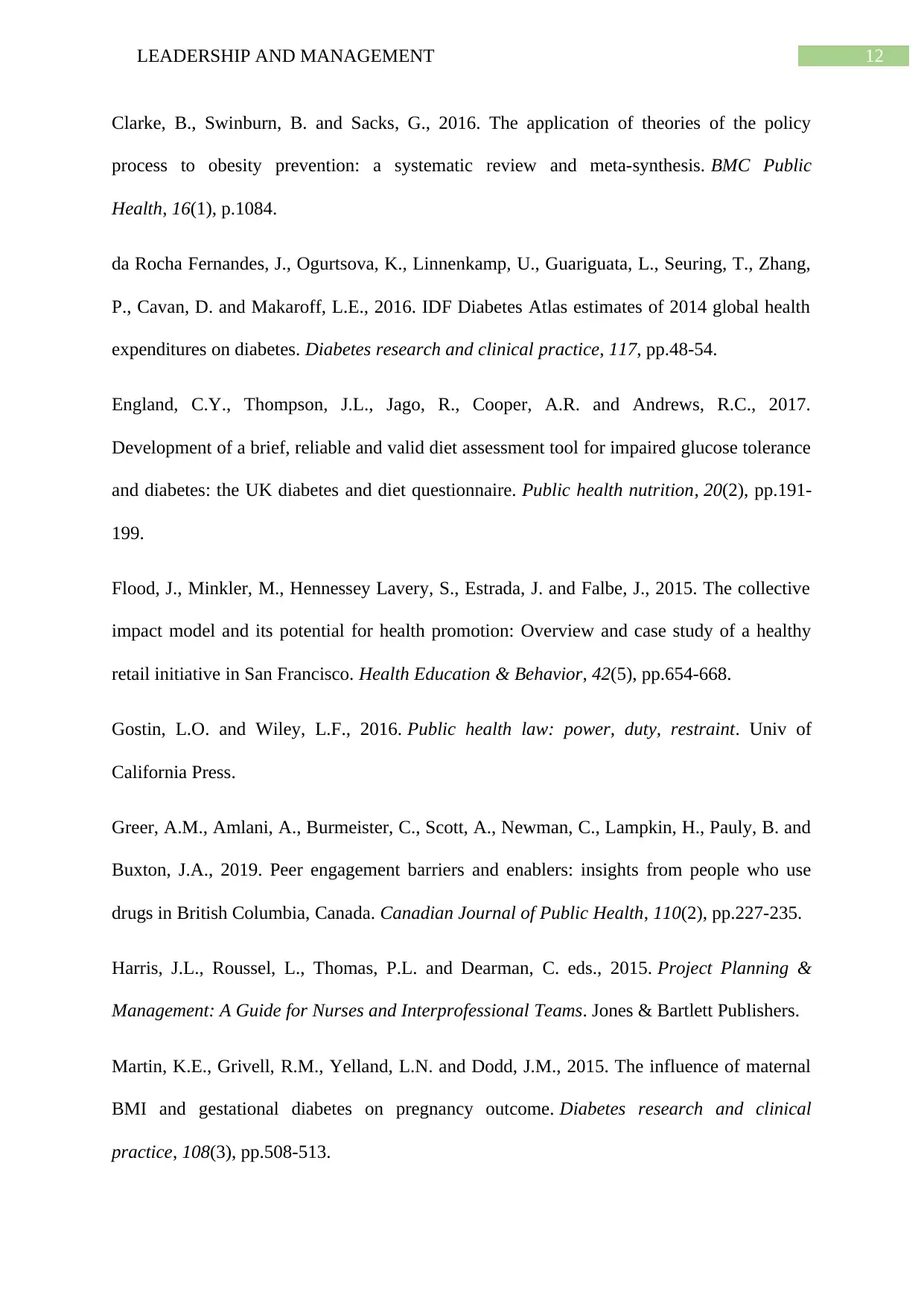
12LEADERSHIP AND MANAGEMENT
Clarke, B., Swinburn, B. and Sacks, G., 2016. The application of theories of the policy
process to obesity prevention: a systematic review and meta-synthesis. BMC Public
Health, 16(1), p.1084.
da Rocha Fernandes, J., Ogurtsova, K., Linnenkamp, U., Guariguata, L., Seuring, T., Zhang,
P., Cavan, D. and Makaroff, L.E., 2016. IDF Diabetes Atlas estimates of 2014 global health
expenditures on diabetes. Diabetes research and clinical practice, 117, pp.48-54.
England, C.Y., Thompson, J.L., Jago, R., Cooper, A.R. and Andrews, R.C., 2017.
Development of a brief, reliable and valid diet assessment tool for impaired glucose tolerance
and diabetes: the UK diabetes and diet questionnaire. Public health nutrition, 20(2), pp.191-
199.
Flood, J., Minkler, M., Hennessey Lavery, S., Estrada, J. and Falbe, J., 2015. The collective
impact model and its potential for health promotion: Overview and case study of a healthy
retail initiative in San Francisco. Health Education & Behavior, 42(5), pp.654-668.
Gostin, L.O. and Wiley, L.F., 2016. Public health law: power, duty, restraint. Univ of
California Press.
Greer, A.M., Amlani, A., Burmeister, C., Scott, A., Newman, C., Lampkin, H., Pauly, B. and
Buxton, J.A., 2019. Peer engagement barriers and enablers: insights from people who use
drugs in British Columbia, Canada. Canadian Journal of Public Health, 110(2), pp.227-235.
Harris, J.L., Roussel, L., Thomas, P.L. and Dearman, C. eds., 2015. Project Planning &
Management: A Guide for Nurses and Interprofessional Teams. Jones & Bartlett Publishers.
Martin, K.E., Grivell, R.M., Yelland, L.N. and Dodd, J.M., 2015. The influence of maternal
BMI and gestational diabetes on pregnancy outcome. Diabetes research and clinical
practice, 108(3), pp.508-513.
Clarke, B., Swinburn, B. and Sacks, G., 2016. The application of theories of the policy
process to obesity prevention: a systematic review and meta-synthesis. BMC Public
Health, 16(1), p.1084.
da Rocha Fernandes, J., Ogurtsova, K., Linnenkamp, U., Guariguata, L., Seuring, T., Zhang,
P., Cavan, D. and Makaroff, L.E., 2016. IDF Diabetes Atlas estimates of 2014 global health
expenditures on diabetes. Diabetes research and clinical practice, 117, pp.48-54.
England, C.Y., Thompson, J.L., Jago, R., Cooper, A.R. and Andrews, R.C., 2017.
Development of a brief, reliable and valid diet assessment tool for impaired glucose tolerance
and diabetes: the UK diabetes and diet questionnaire. Public health nutrition, 20(2), pp.191-
199.
Flood, J., Minkler, M., Hennessey Lavery, S., Estrada, J. and Falbe, J., 2015. The collective
impact model and its potential for health promotion: Overview and case study of a healthy
retail initiative in San Francisco. Health Education & Behavior, 42(5), pp.654-668.
Gostin, L.O. and Wiley, L.F., 2016. Public health law: power, duty, restraint. Univ of
California Press.
Greer, A.M., Amlani, A., Burmeister, C., Scott, A., Newman, C., Lampkin, H., Pauly, B. and
Buxton, J.A., 2019. Peer engagement barriers and enablers: insights from people who use
drugs in British Columbia, Canada. Canadian Journal of Public Health, 110(2), pp.227-235.
Harris, J.L., Roussel, L., Thomas, P.L. and Dearman, C. eds., 2015. Project Planning &
Management: A Guide for Nurses and Interprofessional Teams. Jones & Bartlett Publishers.
Martin, K.E., Grivell, R.M., Yelland, L.N. and Dodd, J.M., 2015. The influence of maternal
BMI and gestational diabetes on pregnancy outcome. Diabetes research and clinical
practice, 108(3), pp.508-513.
Paraphrase This Document
Need a fresh take? Get an instant paraphrase of this document with our AI Paraphraser
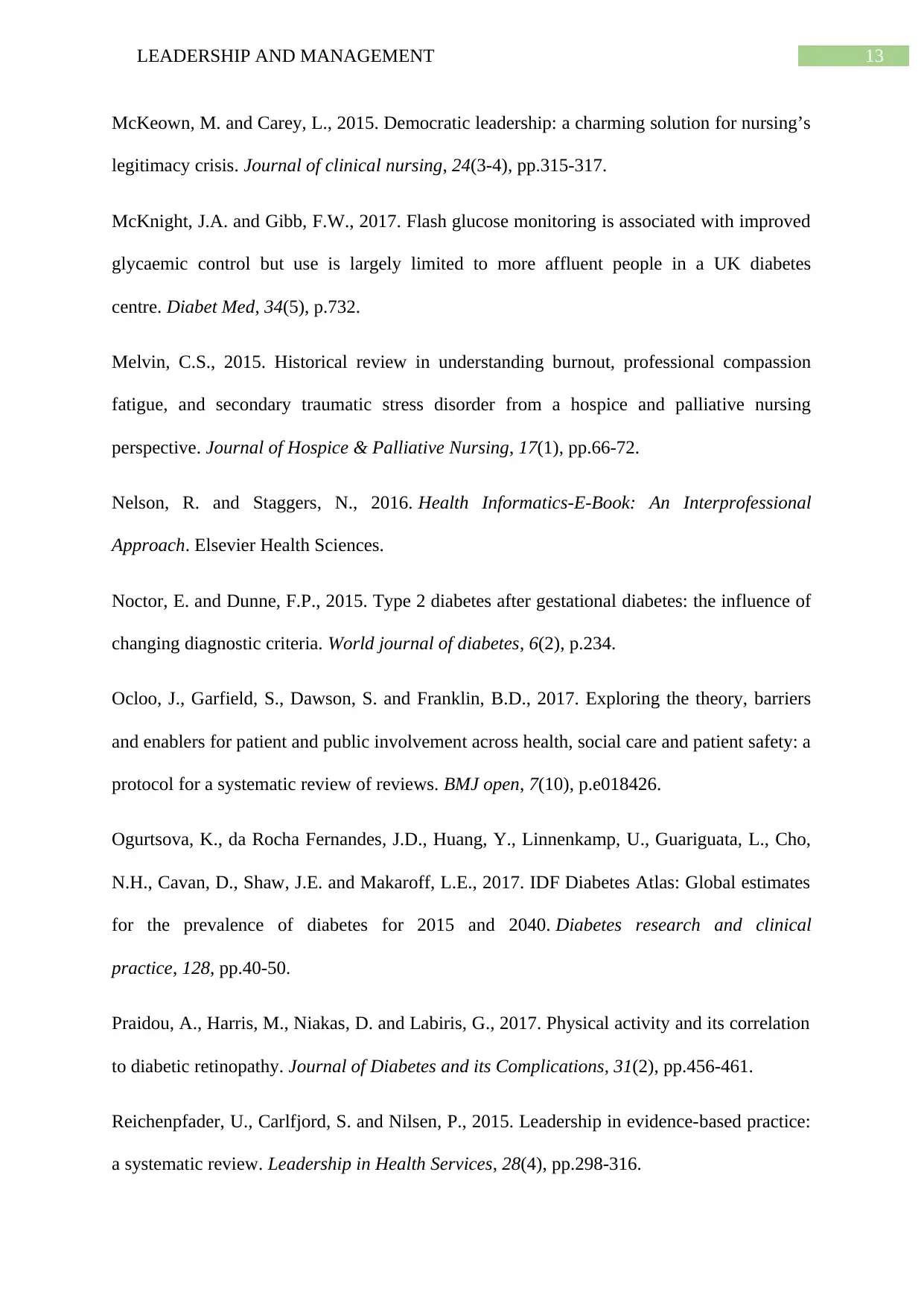
13LEADERSHIP AND MANAGEMENT
McKeown, M. and Carey, L., 2015. Democratic leadership: a charming solution for nursing’s
legitimacy crisis. Journal of clinical nursing, 24(3-4), pp.315-317.
McKnight, J.A. and Gibb, F.W., 2017. Flash glucose monitoring is associated with improved
glycaemic control but use is largely limited to more affluent people in a UK diabetes
centre. Diabet Med, 34(5), p.732.
Melvin, C.S., 2015. Historical review in understanding burnout, professional compassion
fatigue, and secondary traumatic stress disorder from a hospice and palliative nursing
perspective. Journal of Hospice & Palliative Nursing, 17(1), pp.66-72.
Nelson, R. and Staggers, N., 2016. Health Informatics-E-Book: An Interprofessional
Approach. Elsevier Health Sciences.
Noctor, E. and Dunne, F.P., 2015. Type 2 diabetes after gestational diabetes: the influence of
changing diagnostic criteria. World journal of diabetes, 6(2), p.234.
Ocloo, J., Garfield, S., Dawson, S. and Franklin, B.D., 2017. Exploring the theory, barriers
and enablers for patient and public involvement across health, social care and patient safety: a
protocol for a systematic review of reviews. BMJ open, 7(10), p.e018426.
Ogurtsova, K., da Rocha Fernandes, J.D., Huang, Y., Linnenkamp, U., Guariguata, L., Cho,
N.H., Cavan, D., Shaw, J.E. and Makaroff, L.E., 2017. IDF Diabetes Atlas: Global estimates
for the prevalence of diabetes for 2015 and 2040. Diabetes research and clinical
practice, 128, pp.40-50.
Praidou, A., Harris, M., Niakas, D. and Labiris, G., 2017. Physical activity and its correlation
to diabetic retinopathy. Journal of Diabetes and its Complications, 31(2), pp.456-461.
Reichenpfader, U., Carlfjord, S. and Nilsen, P., 2015. Leadership in evidence-based practice:
a systematic review. Leadership in Health Services, 28(4), pp.298-316.
McKeown, M. and Carey, L., 2015. Democratic leadership: a charming solution for nursing’s
legitimacy crisis. Journal of clinical nursing, 24(3-4), pp.315-317.
McKnight, J.A. and Gibb, F.W., 2017. Flash glucose monitoring is associated with improved
glycaemic control but use is largely limited to more affluent people in a UK diabetes
centre. Diabet Med, 34(5), p.732.
Melvin, C.S., 2015. Historical review in understanding burnout, professional compassion
fatigue, and secondary traumatic stress disorder from a hospice and palliative nursing
perspective. Journal of Hospice & Palliative Nursing, 17(1), pp.66-72.
Nelson, R. and Staggers, N., 2016. Health Informatics-E-Book: An Interprofessional
Approach. Elsevier Health Sciences.
Noctor, E. and Dunne, F.P., 2015. Type 2 diabetes after gestational diabetes: the influence of
changing diagnostic criteria. World journal of diabetes, 6(2), p.234.
Ocloo, J., Garfield, S., Dawson, S. and Franklin, B.D., 2017. Exploring the theory, barriers
and enablers for patient and public involvement across health, social care and patient safety: a
protocol for a systematic review of reviews. BMJ open, 7(10), p.e018426.
Ogurtsova, K., da Rocha Fernandes, J.D., Huang, Y., Linnenkamp, U., Guariguata, L., Cho,
N.H., Cavan, D., Shaw, J.E. and Makaroff, L.E., 2017. IDF Diabetes Atlas: Global estimates
for the prevalence of diabetes for 2015 and 2040. Diabetes research and clinical
practice, 128, pp.40-50.
Praidou, A., Harris, M., Niakas, D. and Labiris, G., 2017. Physical activity and its correlation
to diabetic retinopathy. Journal of Diabetes and its Complications, 31(2), pp.456-461.
Reichenpfader, U., Carlfjord, S. and Nilsen, P., 2015. Leadership in evidence-based practice:
a systematic review. Leadership in Health Services, 28(4), pp.298-316.
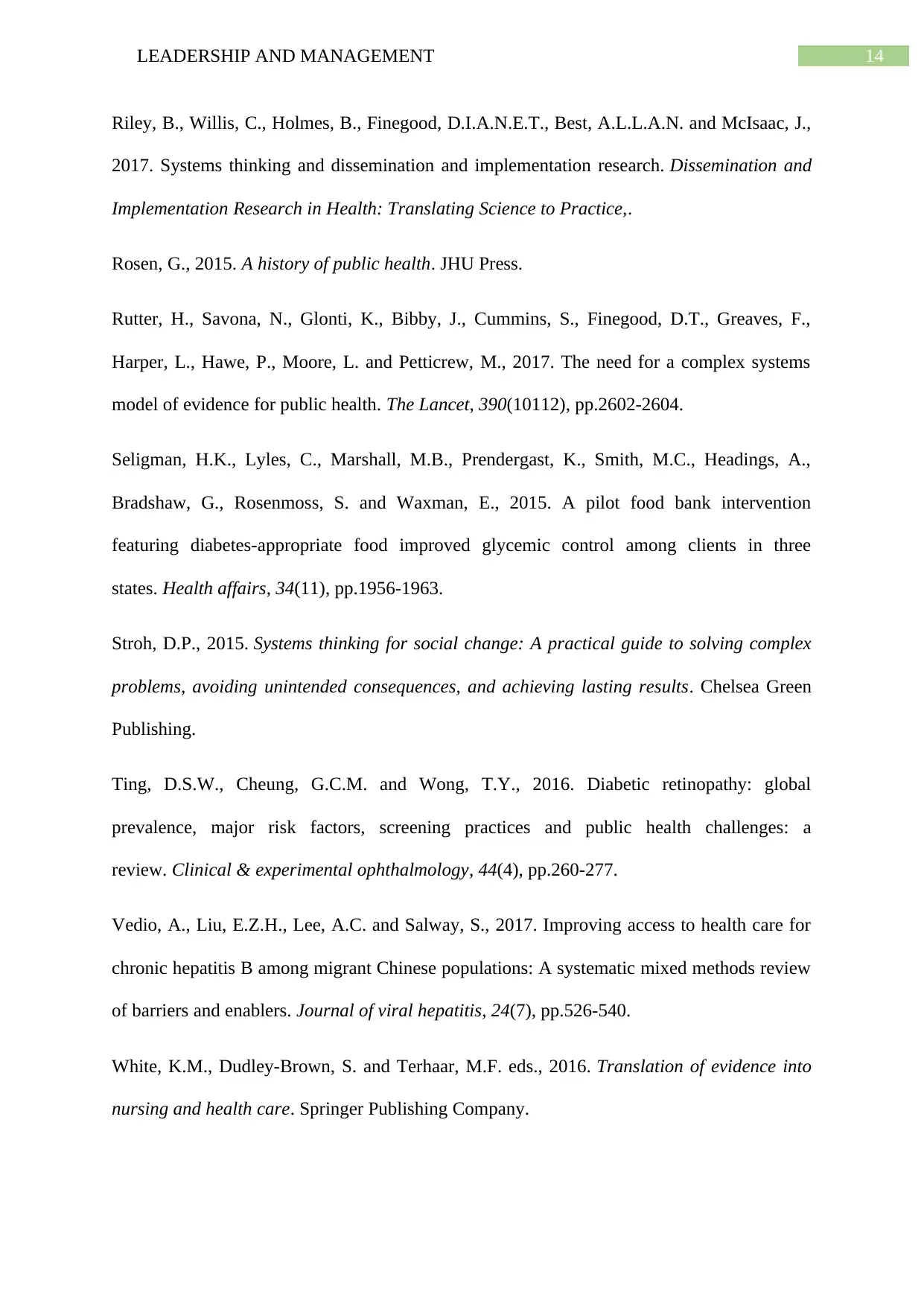
14LEADERSHIP AND MANAGEMENT
Riley, B., Willis, C., Holmes, B., Finegood, D.I.A.N.E.T., Best, A.L.L.A.N. and McIsaac, J.,
2017. Systems thinking and dissemination and implementation research. Dissemination and
Implementation Research in Health: Translating Science to Practice,.
Rosen, G., 2015. A history of public health. JHU Press.
Rutter, H., Savona, N., Glonti, K., Bibby, J., Cummins, S., Finegood, D.T., Greaves, F.,
Harper, L., Hawe, P., Moore, L. and Petticrew, M., 2017. The need for a complex systems
model of evidence for public health. The Lancet, 390(10112), pp.2602-2604.
Seligman, H.K., Lyles, C., Marshall, M.B., Prendergast, K., Smith, M.C., Headings, A.,
Bradshaw, G., Rosenmoss, S. and Waxman, E., 2015. A pilot food bank intervention
featuring diabetes-appropriate food improved glycemic control among clients in three
states. Health affairs, 34(11), pp.1956-1963.
Stroh, D.P., 2015. Systems thinking for social change: A practical guide to solving complex
problems, avoiding unintended consequences, and achieving lasting results. Chelsea Green
Publishing.
Ting, D.S.W., Cheung, G.C.M. and Wong, T.Y., 2016. Diabetic retinopathy: global
prevalence, major risk factors, screening practices and public health challenges: a
review. Clinical & experimental ophthalmology, 44(4), pp.260-277.
Vedio, A., Liu, E.Z.H., Lee, A.C. and Salway, S., 2017. Improving access to health care for
chronic hepatitis B among migrant Chinese populations: A systematic mixed methods review
of barriers and enablers. Journal of viral hepatitis, 24(7), pp.526-540.
White, K.M., Dudley-Brown, S. and Terhaar, M.F. eds., 2016. Translation of evidence into
nursing and health care. Springer Publishing Company.
Riley, B., Willis, C., Holmes, B., Finegood, D.I.A.N.E.T., Best, A.L.L.A.N. and McIsaac, J.,
2017. Systems thinking and dissemination and implementation research. Dissemination and
Implementation Research in Health: Translating Science to Practice,.
Rosen, G., 2015. A history of public health. JHU Press.
Rutter, H., Savona, N., Glonti, K., Bibby, J., Cummins, S., Finegood, D.T., Greaves, F.,
Harper, L., Hawe, P., Moore, L. and Petticrew, M., 2017. The need for a complex systems
model of evidence for public health. The Lancet, 390(10112), pp.2602-2604.
Seligman, H.K., Lyles, C., Marshall, M.B., Prendergast, K., Smith, M.C., Headings, A.,
Bradshaw, G., Rosenmoss, S. and Waxman, E., 2015. A pilot food bank intervention
featuring diabetes-appropriate food improved glycemic control among clients in three
states. Health affairs, 34(11), pp.1956-1963.
Stroh, D.P., 2015. Systems thinking for social change: A practical guide to solving complex
problems, avoiding unintended consequences, and achieving lasting results. Chelsea Green
Publishing.
Ting, D.S.W., Cheung, G.C.M. and Wong, T.Y., 2016. Diabetic retinopathy: global
prevalence, major risk factors, screening practices and public health challenges: a
review. Clinical & experimental ophthalmology, 44(4), pp.260-277.
Vedio, A., Liu, E.Z.H., Lee, A.C. and Salway, S., 2017. Improving access to health care for
chronic hepatitis B among migrant Chinese populations: A systematic mixed methods review
of barriers and enablers. Journal of viral hepatitis, 24(7), pp.526-540.
White, K.M., Dudley-Brown, S. and Terhaar, M.F. eds., 2016. Translation of evidence into
nursing and health care. Springer Publishing Company.
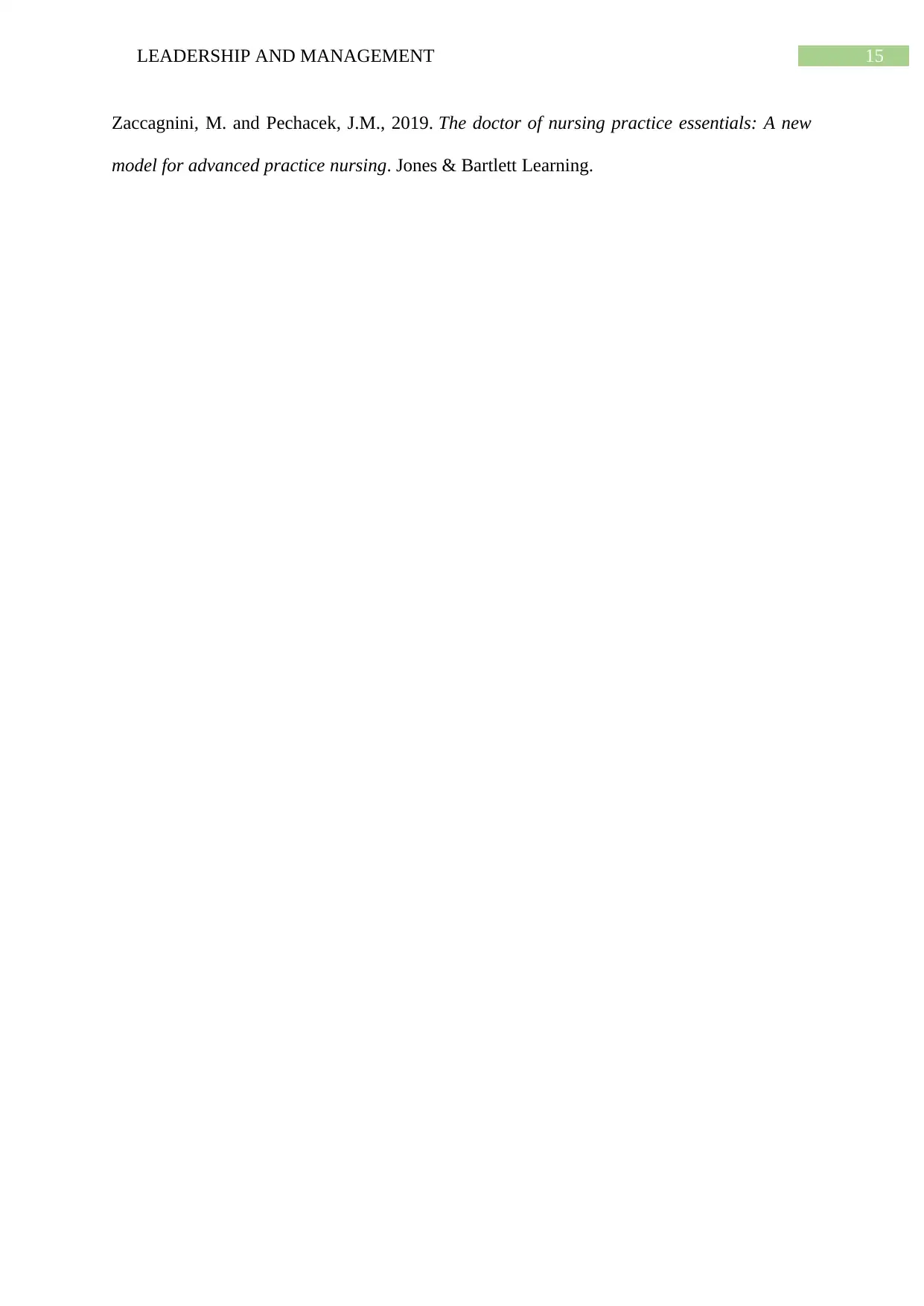
15LEADERSHIP AND MANAGEMENT
Zaccagnini, M. and Pechacek, J.M., 2019. The doctor of nursing practice essentials: A new
model for advanced practice nursing. Jones & Bartlett Learning.
Zaccagnini, M. and Pechacek, J.M., 2019. The doctor of nursing practice essentials: A new
model for advanced practice nursing. Jones & Bartlett Learning.
1 out of 16
Related Documents
Your All-in-One AI-Powered Toolkit for Academic Success.
+13062052269
info@desklib.com
Available 24*7 on WhatsApp / Email
![[object Object]](/_next/static/media/star-bottom.7253800d.svg)
Unlock your academic potential
© 2024 | Zucol Services PVT LTD | All rights reserved.





